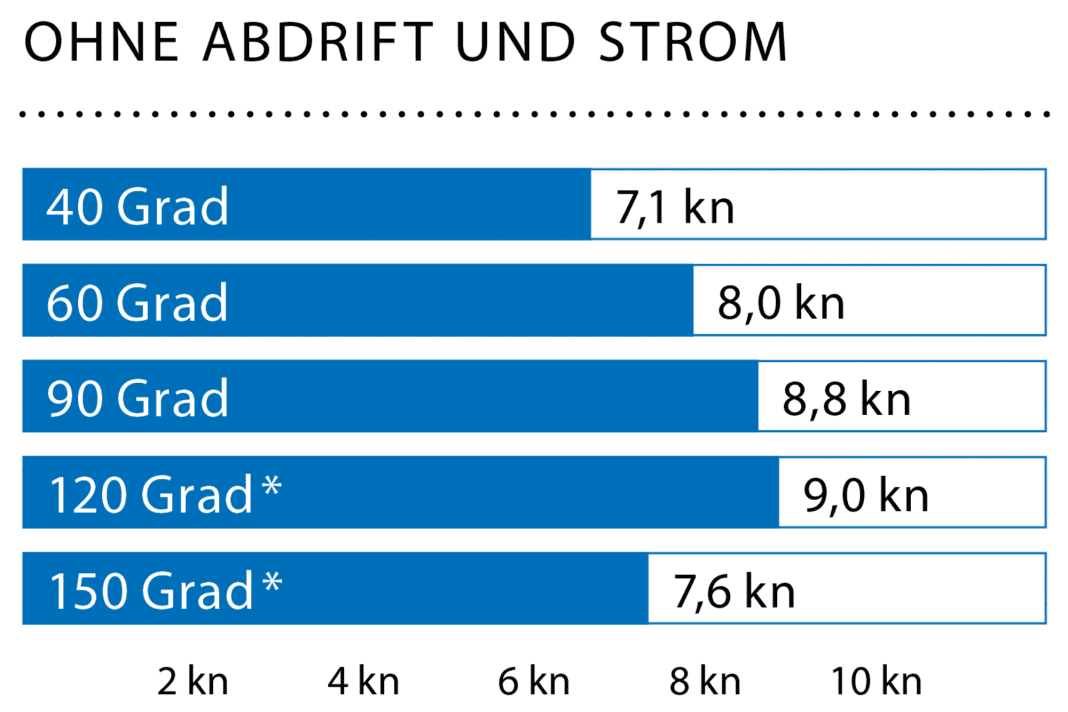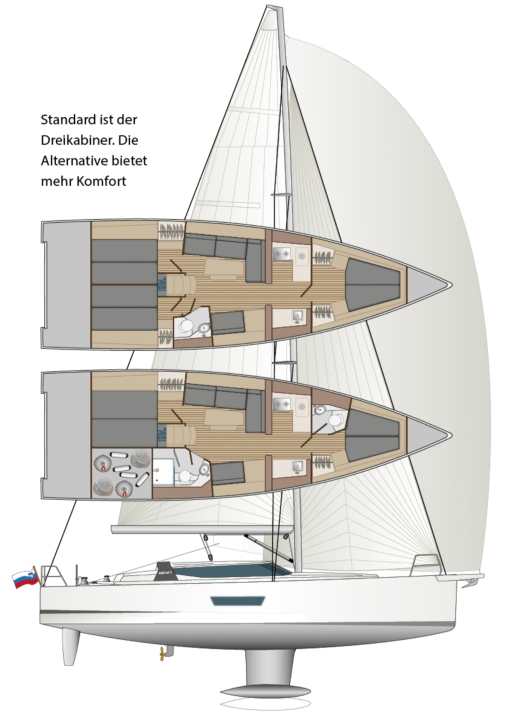Elan GT5: Blue water tourer shows its origins as a performance cruiser in the test






Basically, it is a plan that is as simple as it is smart and therefore quite common: you simply take a good, fast hull from existing moulds, add a new interior and a new deck on top - and the ship is ready for the completely new shipyard line. Specifically in this case: Elan Yachts in Slovenia expanded its range with a third model series called Grand Turismo. The concept: uncompromising, unrestricted living comfort, even for longer voyages, plus good sailing characteristics. Nothing new, you might think. Far from it!
The GT5 launch model is based on the hull of the former Elan 400 (test in YACHT 10/13). The attractive and powerful performance cruiser from designer Rob Humphreys is now available in the Elan programme under the name E5 or as the sportier S5 version. Elan Yachts has developed a completely new interior for the GT5 version, with a saloon at a higher level (semi-deck saloon), a galley at the front of the main bulkhead and more space in the cabins. And to ensure that there is still sufficient space and height inside, the boat has a separate deck with a raised cabin superstructure in the DS look.
More boats in the YACHT test:
However, the metamorphosis from performance cruiser to pure tourer is not quite so straightforward. The new boat is around 1.2 tonnes heavier than its sporty sister. The extra pounds are mainly due to the luxurious and lavish interior fittings. Due to the increased weight and the resulting lower buoyancy, Rob Humphreys had to completely recalculate and optimise his design for the GT5.
The solution: The hull is extended by 45 centimetres at the rear and raised by 12 centimetres at the sides. To achieve this, the existing design can be supplemented with appropriate inserts. The keel, on the other hand, remains unchanged in a T-shape and is also attached to the hull in the same place despite the additional hull length.
Pleasure in strong winds
So the question of whether the GT5 would also be able to show the good performance values of its sisters E5 and S5 despite these not insignificant adjustments was an exciting one. The test area off Portoroz on the Slovenian Adriatic coast offers the perfect conditions for clarifying this, because they are highly variable, with strong winds and hammer gusts of over 30 knots right down to a weak draft.
In good winds of 12 knots and more, the new GT5 tourer presents itself from its best side. The Elan lives up to its name. It behaves dynamically and powerfully and has no trouble with high winds and waves outside the land cover. The double and perfectly tuned rudders make it very easy for the helmsman to steer the GT5 optimally upwind at all times and realise its full potential. The boat reacts vividly and immediately, and it also remains well controllable on course at all times. Sunning is hardly an issue, even when heeling a lot.
In 15 knots of wind, the new Elan manages 7.1 knots on a course of 40 degrees to the true wind. These are excellent performance values for a boat of this orientation. For comparison: according to polar diagrams, the sporty counterpart E5 should only run around 0.3 knots faster in the same wind and at the same height.
The GT5 provides a big surprise on the courses with the wind. With a gennaker and at an angle of 120 degrees, the boat reaches 9.0 knots and more. The powerful hull with its pronounced chines shows its crisp potential again and again. What's more, in a strong wind test at over 25 knots, it was even possible to log speeds of over 12 knots with just the main and genoa.
Frustration in a lull
However, when the wind picks up, the boat weakens noticeably under its additional weight. The performance values drop faster than expected and spoil the enjoyment of the good performance in stronger winds. Below 10 knots, the GT5, like so many modern cruising boats, soon feels under-rigged, lacking pressure in the rig and therefore also on the rudders. It is also annoying that the wide stern dips quite deeply at low speeds and constantly draws in a lot of water. Designer Rob Humphreys calculates that the GT5 floats at least five centimetres lower than the much lighter E5 for weight reasons. That is considerable.
The test boat (construction number 2) is equipped with the optional short overlapping genoa. As standard, the boat would be delivered with a self-tacking jib. A furling Code Zero could therefore be a good addition to the wardrobe and increase the pleasure factor in light winds. For this and for the gennaker, a carbon fibre bowsprit can be permanently attached to the GT5 at the buyer's request. The trunk also serves as an anchor holder and step.
Surcharge for larger winches is worthwhile
Halyards, sheets and trim lines are generally led below deck to the front of the two steering columns and can therefore be reached by the helmsman: From his position, he can easily operate the aft mainsheet and halyard winches as well as the stopper batteries in front. The forward winch for the genoa sheet also remains within easy reach of the helmsman. However, solo sailors are more likely to opt for the standard sails with self-tacking jib anyway. This means that the GT5 is also uncompromisingly suitable for single-handed sailing.
The 46 mm winches on the test boat are an upgrade; only 40 mm drums are fitted as standard. The surcharge is particularly worthwhile for the mainsheet guide, which runs on the coachroof via a less efficient cockpot guide that is attached far forward on the main boom. A lot of force is needed to haul the sail tight in windy conditions. The advantage of this arrangement is that the cockpit is completely free of the mainsheet guide.
The folding bathing platform is available in two versions. The larger version closes off the cockpit at the rear up to the height of the running deck. This is a good choice for family sailors with small children. The smaller platform, as on the test boat, is visually more attractive and only extends to the height of the floor, leaving the cockpit open. This variant offers more advantages for easier entry and exit via the stern. It is strange that in both cases the unfolded bathing platform rests directly on the surface of the water. This is undoubtedly great for bathing, but not very practical for lying in the harbour.
In the spirit of the times
The yacht builders in Slovenia have opted for an unusual layout for the interior of the GT5, but one that is increasingly in demand on the market: the galley at the front of the main bulkhead. This arrangement is currently in vogue, especially for larger yachts over 50 feet in length. Bavaria Yachtbau, for example, is also following this concept with the C57. The GT5, on the other hand, is a pioneer in the 40-foot touring segment. The layout below deck is ideal because the semi-deck saloon is raised by 18 centimetres. However, the galley in front remains installed at a lower level, which creates the desired spatial separation. Although the GT5's massive cabin superstructure slopes steeply forward towards the mast, the headroom in the entire galley area is still at least 1.90 metres.
The standard boat is the three-cabin boat with the wet room aft. An additional toilet room can be installed in the foredeck as an extension option. As an owner's boat, the Elan GT5 is also available with two double cabins, like the test boat. In this case, the aft bathroom is extended by a beautifully separated shower area. In addition, the aft cabin on the port side is significantly larger because the longitudinal bulkhead is installed well above the centre of the boat. This benefits the square double berth at the rear, which is 1.70 metres wide throughout.
Robust design on the inside
As a two-cabin model, the GT5 has a huge, deep storage space in the back, which is also accessible through the wet room. Or rather, it has to be accessible. This is because the forecastle has no partitions or lockers ex shipyard. The stowed items cannot be reached from the cockpit. What's more, the cut-out for the locker lid is very small. Sail bags, for example, cannot be stowed properly. The shipyard should make improvements here.
The exceptionally beautiful and high-quality interior fittings are much more pleasing. Elan clearly uses many solid wood components, especially for edge mouldings, handrails and door frames. The robustness of the furniture and all other built-in parts is particularly striking. Wherever you reach, you can literally feel the very solid design; nothing wobbles or creaks. The high-quality add-on parts and fittings in all areas match this. In terms of build quality, Elan's GT5 is a winner, especially in comparison to many products from the larger construction series.
Fresh approach
Elan's unusual GT concept has little direct competition on the market, at least not in this length class. It is therefore difficult to categorise the costs. However, the basic price of 460,411 euros seems fairly calculated, especially when you consider the good and robust construction of the hull using the vacuum infusion process with vinyl ester resin, the uncompromisingly high-quality deck equipment and the upmarket design of the interior fittings.
Elan's GT concept is exciting because the approach is different. The idea of converting the hull of a performance cruiser into a touring boat with a deck saloon is more than just courageous and will not find many imitators in the future. In this case, however, everything fits together quite well. The mission has been accomplished.
The measured values for testing the Elan GT5






The Elan GT5 in detail

Technical data of the Elan GT5
- Designer: Rob Humphreys
- CE design category: A
- Torso length: 12,41 m
- Total length: 13,20 m
- Waterline length: 11,58 m
- Width: 3,91 m
- Draught/alternative: 2,45/2,20 m
- Theoretical torso speed: 8.3 kn
- Weight: 8,1 t
- Ballast/proportion: 2,7 t/33 %
- Mast height above waterline: 18,39 m
- Mainsail: 46,2 m²
- Self-tacking jib: 38,1 m²
- machine (Volvo P.): 28 kW/38 hp
- Fuel tank (plastic): 170 l
- Fresh water tank (plastic): 220 l
- Holding tank (plastic): 50 l
Hull and deck construction
GRP sandwich construction with foam core. Built using the vacuum infusion process with vinyl ester resin. Composite laminated bulkheads
Price and shipyard
- Base price ex shipyard: 460,411 € (incl. VAT)
- Standard equipment included: engine, sheets, railing, navigation lights, battery, compass, cushions, galley/cooker, bilge pump, toilet, fire extinguisher, electric coolbox, holding tank w. suction
Shipyard
Elan-Yachts, 4275 Begunje na Gorenjskem (Slovenia); www.elan-yachts.com
Distribution
Blue Yachting, 28717 Bremen; www.blue-yachting.de
YACHT review of the Elan GT5
Bold programme expansion at Elan Yachts. The GT5 performs strongly in windy conditions, but shows weaknesses in light winds. The galley is installed at the front of the main bulkhead, which is a novelty in this size of boat. The build quality can set standards
Design and concept
- + Touring boat with fast hull
- + Useful expansion versions
- + Fair pricing
Sailing performance and trim
- + High performance potential in windy conditions
- - Sluggish mainsheet guide
- - Lack of sail area in light winds
Living and finishing quality
- + Very good finishing quality
- + Generous storage space
- - Shower area only in the two-cabin model
Equipment and technology
- + High-quality basic equipment
- + Bathing platform in two sizes
- - Back box has no subdivision
The article first appeared in YACHT 08/2017 and has been updated for the online version.

